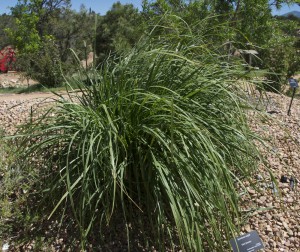Scientific name: Sporobolus wrightii
Common name: giant sacaton, big sacaton
Plant Family: Poaceae
Article by Susan Bruneni

Sporobolus wrightii (Giant Sacaton) by Janice Tucker
Giant sacaton (Sporobolus wrightii) has become a popular feature in drought-tolerant gardens in the Southwest and is readily available to gardeners. Giant sacaton produces showy, feathery floral spikes in the late summer. Plants reach five to seven feet with bloom stalks of three to five feet. This perennial bunchgrass thrives in clay or sandy soil and is salt and drought tolerant. It is hardier than pampas grass, with a similar effect, and uses much less water than other ornamental grasses such as thirsty Miscanthus varieties.
But before the early 1900s, massive stands of giant sacaton were common throughout the Southwest. These massive stands occurred from southeastern Arizona eastward to western Texas and Oklahoma, and south to northern Mexico. They provided shelter for wildlife, including an exclusive nesting habitat for Botteri’s sparrow and were a major source of fodder for livestock. Today, giant sacaton is estimated to occur naturally in only five percent of its previous habitat, due to conversion of habitat to agricultural use and overgrazing. Many former grasslands are now inhabited by invading mesquite and juniper populations.
Giant sacaton grows mainly on low alluvial flats, bottomlands, and arroyos and can also be found in desert wetlands. In New Mexico, it grows normally between 3,100 to 7,000 feet elevations. It is, however, hardy to USDA Zone 5, and will succeed in northern New Mexico gardens up to at least 8,000 feet. Giant sacaton continues producing leaves during the winter. The leaves form within a protective sheath and expand in early spring. Plants will have some green foliage throughout the year.
The Los Lunas Plant Materials Center (NMPMC) serves the semi-arid and arid southwest region. According to their website, environmental conditions, including low precipitation, high intensity rainfall, wind, extreme topography, and varied land uses, combine to produce a variety of problems needing plant material solutions. The Center has provided the Southwest with plant solutions for more than 70 years, developing new vegetative methods for improving rangeland, native landscaping, riparian restoration, wildlife habitat enhancement, native shrub transplanting, and mine reclamation.
In 2011, the USDA natural Resources Conservation Program (Plant Materials) in Los Lunas recommended use of Sporobolus wrightii or big sacaton ‘Windbreaker’ for creating windbreaks to reduce soil erosion from high wind. This variety commonly grows to heights of 10 feet, and has proved popular with gardeners, too.
For more information from NMPMC about giant sacaton, see:
http://www.nrcs.usda.gov/Internet/FSE_PLANTMATERIALS/publications/nmpmcrb10639.pdf
In Healing Herbs of the Upper Rio Grande, Leonora Curtin refers to the similarity of the name sacaton to the Guatemalan word for grass, sacate, a tall grass harvested for broom production. She commented that sacaton was also used to make brooms in New Mexico. And because brooms were associated with witches, an elaborate “witch-proofing” charm created from sacaton was commonly worn.
Other references:
www.fs.fed.us/database/feis/plants/graminoid/spowri/all.html


